入门肠辞谤别.补蝉测苍肠
- 5. コアコンセプト
- 15. 協調スレッド(IOCスレッド) 以下のような場合に制御が別のスレッドに切り替わる 値を受信しようとしたときにバッファが空 値を送信しようとしたときにバッファがいっぱい IOC = Inversion of Control (go (while true (let [v (<! ch)] (println v)))) (go (loop [i 0] (>! ch i) (recur (inc i))))
- 16. 協調スレッド(IOCスレッド) 以下のような場合に制御が別のスレッドに切り替わる 値を受信しようとしたときにバッファが空 値を送信しようとしたときにバッファがいっぱい IOC = Inversion of Control (go (while true (let [v (<! ch)] (println v)))) (go (loop [i 0] (>! ch i) (recur (inc i)))) 上記の場合には??が実行されずに制御が切り替わる(パーク)
- 17. 協調スレッド(IOCスレッド) グリーンスレッド(ネイティブスレッドでない)ので生成の コストが低い シングルスレッドの場合でも使える(ClojureScriptでも!) native thread native thread native thread IOCthread IOCthread IOCthread IOCthread IOCthread IOCthread IOCthread IOCthread IOCthread
- 18. 基本的な础笔滨の使い方
- 19. チャネル生成と送受信 チャネル生成:chan 送信:>!, >!! 受信:<!, <!! (let [ch (chan 2)] (>!! ch 0) (>!! ch 1) [(<!! ch) (<!! ch)]) ;=> [0 1]
- 20. チャネル生成と送受信 チャネル生成:chan 送信:>!, >!! 受信:<!, <!! (let [ch (chan 2)] (>!! ch 0) (>!! ch 1) [(<!! ch) (<!! ch)]) ;=> [0 1] バッファのサイズを指定
- 21. チャネル生成と送受信 ブロッキング ノンブロッキング 送信 >!! バッファが一杯ならブロック >! バッファが一杯ならパーク 受信 <!! バッファが空ならブロック <! バッファが空ならパーク
- 22. チャネル生成と送受信 ブロッキング ノンブロッキング 送信 >!! バッファが一杯ならブロック >! バッファが一杯ならパーク 受信 <!! バッファが空ならブロック <! バッファが空ならパーク 後述のgoマクロ内でのみ使用可
- 23. goマクロ 協調スレッドで処理を実行する (let [ch (chan 2)] (go (while true (let [v (<! ch)] (println “received” v)))) (>!! ch “hi”) (>!! ch “there”)) ;; received hi ;; received there
- 24. timeout (let [t (timeout 100) begin (System/currentTimeMillis)] (<!! t) (println “Waited” (- (System/currentTimeMillis) begin))) ;; Waited 100 タイムアウト用のチャネルを生成する
- 25. alts! 一度に複数のチャネルから待ち受ける (let [c1 (chan) c2 (chan)] (go (while true (let [[v ch] (alts! [c1 c2])] (println “received" v)))) (go (>! c1 "hi")) (go (>! c2 "there"))) ;; received hi ;; received there
- 26. alts! 一度に複数のチャネルから待ち受ける (let [c1 (chan) c2 (chan)] (go (while true (let [[v ch] (alts! [c1 c2])] (println “received" v)))) (go (>! c1 "hi")) (go (>! c2 "there"))) ;; received hi ;; received there 待ち受けるチャネル
- 27. alts! 一度に複数のチャネルから待ち受ける (let [c1 (chan) c2 (chan)] (go (while true (let [[v ch] (alts! [c1 c2])] (println “received" v)))) (go (>! c1 "hi")) (go (>! c2 "there"))) ;; received hi ;; received there 待ち受けるチャネル 受信した値と受信元のチャネルが返る
- 28. alts! + timeout 受信を待ち受ける時間にタイムアウトを設定 (go (let [c (chan) begin (System/currentTimeMillis)] (alts! [c (timeout 100)]) (println "Gave up after” (- (System/currentTimeMillis) begin)))
- 30. ちょっと进んだトピック
- 31. ちょっと进んだトピック チャネル間の連携 高レベルAPI deprecated API vs transducers
- 34. 高レベルAPI その他、into, merge, reduce, take 等が用意 されている (defn split [p ch] (let [tc (chan), fc (chan)] (go (loop [] (let [v (<! ch)] (if (nil? v) (do (close! tc) (close! fc)) (when (>! (if (p v) tc fc) v) (recur)))))) [tc fc])) c.c.a/splitの定義(一部簡略化)
- 35. deprecated API vs transducers 高レベルAPIで提供されるような、チャネルか ら得られる値を加工したいケースは多い channel ??? channel
- 36. deprecated API vs transducers core.asyncではチャネル用のmapや?lterも提 供していた (let [ch (to-chan (range))] [(<!! ch) (<!! ch) (<!! ch)]) ;=> [0 1 2] (let [ch (->> (to-chan (range)) (map< inc) (map< #(* % %)))] [(<!! ch) (<!! ch) (<!! ch)]) ;=> [1 4 9]
- 37. deprecated API vs transducers Clojure 1.7以降ではtransducerを使って同様の処理が書ける チャネル生成時にtransducerを指定するとチャネルから取得 できる値はtransducerを適用した結果の値になる (let [xform (comp (map inc) (map #(* % %))) ch (pipe (to-chan (range)) (chan 1 xform))] [(<!! ch) (<!! ch) (<!! ch)]) ;=> [1 4 9] transducer

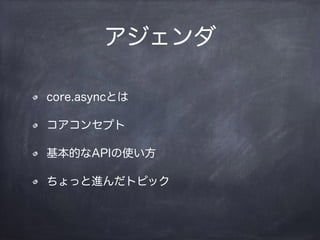
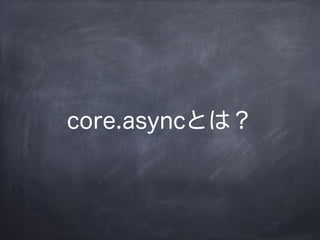
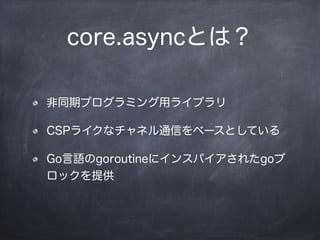


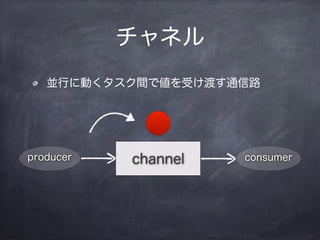
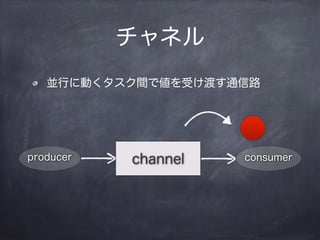
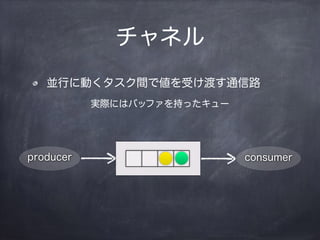
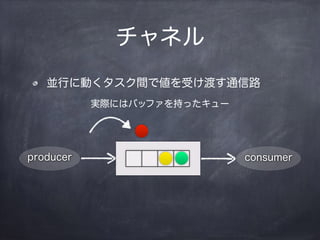
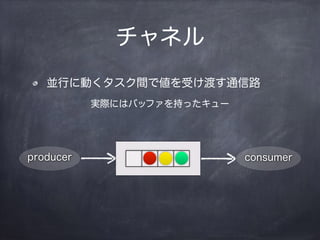
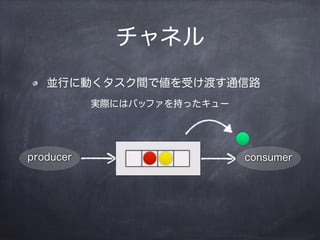
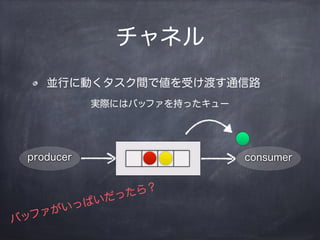
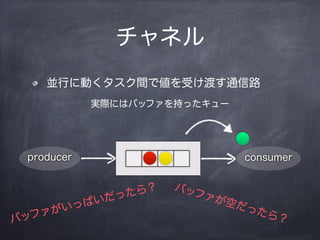
![協調スレッド(IOCスレッド)
以下のような場合に制御が別のスレッドに切り替わる
値を受信しようとしたときにバッファが空
値を送信しようとしたときにバッファがいっぱい
IOC = Inversion of Control
(go
(while true
(let [v (<! ch)]
(println v))))
(go
(loop [i 0]
(>! ch i)
(recur (inc i))))](https://image.slidesharecdn.com/coreasync-150611095123-lva1-app6891/85/core-async-15-320.jpg)
![協調スレッド(IOCスレッド)
以下のような場合に制御が別のスレッドに切り替わる
値を受信しようとしたときにバッファが空
値を送信しようとしたときにバッファがいっぱい
IOC = Inversion of Control
(go
(while true
(let [v (<! ch)]
(println v))))
(go
(loop [i 0]
(>! ch i)
(recur (inc i))))
上記の場合には??が実行されずに制御が切り替わる(パーク)](https://image.slidesharecdn.com/coreasync-150611095123-lva1-app6891/85/core-async-16-320.jpg)
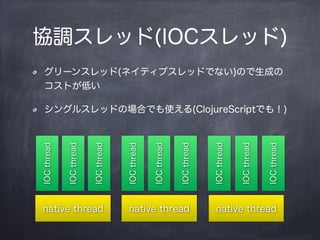

![チャネル生成と送受信
チャネル生成:chan
送信:>!, >!!
受信:<!, <!!
(let [ch (chan 2)]
(>!! ch 0)
(>!! ch 1)
[(<!! ch) (<!! ch)])
;=> [0 1]](https://image.slidesharecdn.com/coreasync-150611095123-lva1-app6891/85/core-async-19-320.jpg)
![チャネル生成と送受信
チャネル生成:chan
送信:>!, >!!
受信:<!, <!!
(let [ch (chan 2)]
(>!! ch 0)
(>!! ch 1)
[(<!! ch) (<!! ch)])
;=> [0 1]
バッファのサイズを指定](https://image.slidesharecdn.com/coreasync-150611095123-lva1-app6891/85/core-async-20-320.jpg)

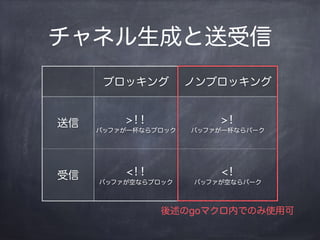
![goマクロ
協調スレッドで処理を実行する
(let [ch (chan 2)]
(go (while true
(let [v (<! ch)]
(println “received” v))))
(>!! ch “hi”)
(>!! ch “there”))
;; received hi
;; received there](https://image.slidesharecdn.com/coreasync-150611095123-lva1-app6891/85/core-async-23-320.jpg)
![timeout
(let [t (timeout 100)
begin (System/currentTimeMillis)]
(<!! t)
(println “Waited”
(- (System/currentTimeMillis)
begin)))
;; Waited 100
タイムアウト用のチャネルを生成する](https://image.slidesharecdn.com/coreasync-150611095123-lva1-app6891/85/core-async-24-320.jpg)
![alts!
一度に複数のチャネルから待ち受ける
(let [c1 (chan)
c2 (chan)]
(go (while true
(let [[v ch] (alts! [c1 c2])]
(println “received" v))))
(go (>! c1 "hi"))
(go (>! c2 "there")))
;; received hi
;; received there](https://image.slidesharecdn.com/coreasync-150611095123-lva1-app6891/85/core-async-25-320.jpg)
![alts!
一度に複数のチャネルから待ち受ける
(let [c1 (chan)
c2 (chan)]
(go (while true
(let [[v ch] (alts! [c1 c2])]
(println “received" v))))
(go (>! c1 "hi"))
(go (>! c2 "there")))
;; received hi
;; received there
待ち受けるチャネル](https://image.slidesharecdn.com/coreasync-150611095123-lva1-app6891/85/core-async-26-320.jpg)
![alts!
一度に複数のチャネルから待ち受ける
(let [c1 (chan)
c2 (chan)]
(go (while true
(let [[v ch] (alts! [c1 c2])]
(println “received" v))))
(go (>! c1 "hi"))
(go (>! c2 "there")))
;; received hi
;; received there
待ち受けるチャネル
受信した値と受信元のチャネルが返る](https://image.slidesharecdn.com/coreasync-150611095123-lva1-app6891/85/core-async-27-320.jpg)
![alts! + timeout
受信を待ち受ける時間にタイムアウトを設定
(go
(let [c (chan)
begin (System/currentTimeMillis)]
(alts! [c (timeout 100)])
(println "Gave up after”
(- (System/currentTimeMillis)
begin)))](https://image.slidesharecdn.com/coreasync-150611095123-lva1-app6891/85/core-async-28-320.jpg)
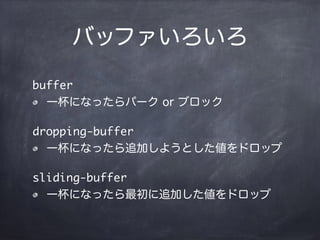

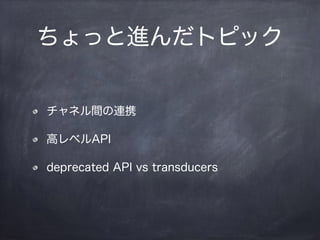
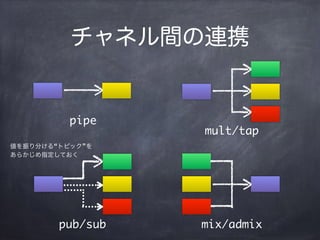

![高レベルAPI
その他、into, merge, reduce, take 等が用意
されている
(defn split [p ch]
(let [tc (chan), fc (chan)]
(go (loop []
(let [v (<! ch)]
(if (nil? v)
(do (close! tc) (close! fc))
(when (>! (if (p v) tc fc) v)
(recur))))))
[tc fc]))
c.c.a/splitの定義(一部簡略化)](https://image.slidesharecdn.com/coreasync-150611095123-lva1-app6891/85/core-async-34-320.jpg)
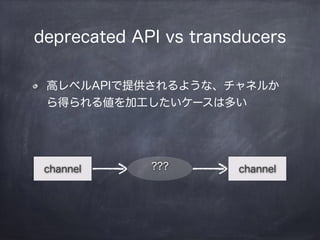
![deprecated API vs transducers
core.asyncではチャネル用のmapや?lterも提
供していた
(let [ch (to-chan (range))]
[(<!! ch) (<!! ch) (<!! ch)])
;=> [0 1 2]
(let [ch (->> (to-chan (range))
(map< inc)
(map< #(* % %)))]
[(<!! ch) (<!! ch) (<!! ch)])
;=> [1 4 9]](https://image.slidesharecdn.com/coreasync-150611095123-lva1-app6891/85/core-async-36-320.jpg)
![deprecated API vs transducers
Clojure 1.7以降ではtransducerを使って同様の処理が書ける
チャネル生成時にtransducerを指定するとチャネルから取得
できる値はtransducerを適用した結果の値になる
(let [xform (comp (map inc)
(map #(* % %)))
ch (pipe (to-chan (range))
(chan 1 xform))]
[(<!! ch) (<!! ch) (<!! ch)])
;=> [1 4 9]
transducer](https://image.slidesharecdn.com/coreasync-150611095123-lva1-app6891/85/core-async-37-320.jpg)

























































